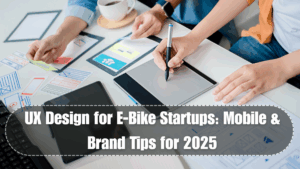The electric two-wheeler market in 2025 is booming like never before. With more e-bike startups entering the scene, the focus is no longer just on performance and battery range—it’s also about delivering a seamless and engaging user experience. Strong design principles for e-bike startups now determine how well a brand stands out in a crowded, fast-evolving space.
From intuitive app interfaces to sleek packaging, every touchpoint is an opportunity to build trust, loyalty, and recognition. Whether it’s a last-mile delivery solution or a stylish urban commuter bike, ebike UX design is now at the core of every successful product. Startups that invest in smart UX, clear visual identity, and mobile-first branding are leading the electric mobility wave in 2025.

Why UX matters for electric two-wheeler startups
In the digital-first era of transportation, user experience has become the silent salesperson for mobility brands. For e-bike startups, this means more than just building an electric bike—it’s about crafting a complete journey from app onboarding to customer support.
Here’s why design principles for e-bike startups are vital:
-
Brand perception: A good design builds instant credibility in a crowded market.
-
User retention: An easy-to-use mobile app and dashboard keep riders engaged and loyal.
-
Customer support: UX flows directly influence how quickly issues get resolved.
-
Product visibility: A well-branded bike and app stand out on roads and app stores alike.
Whether you’re launching a scooter-sharing app, a consumer retail e-bike, or a delivery vehicle, mobility branding and interface design have become must-haves—not just nice-to-haves.
Mobile app design: where UX begins
For most electric mobility users, their first interaction with a brand is through its app. That’s why app design tips for e-bike startups are getting special attention in 2025. Here’s what the top UX teams are prioritizing:
-
Minimalist dashboards: Clear speed, battery, trip data—shown in one glance.
-
Dark mode and accessibility: Important for battery saving and visibility on the move.
-
Bluetooth connectivity flows: Simple pairing, auto-reconnect, and firmware update notifications.
-
Ride summary screens: Visual analytics of distance, CO2 saved, cost comparison.
-
Service request integration: In-app booking for repairs or troubleshooting.
All of these ebike UX design elements help reduce friction and make the rider experience feel smart, efficient, and empowering.
Key design principles for e-bike startups in 2025
Let’s explore some fundamental design principles for e-bike startups that are defining 2025’s electric mobility ecosystem:
| Principle | Description |
|---|---|
| Mobile-first thinking | Prioritizing smartphone-based interaction for riders and fleet managers |
| Visual simplicity | Clean, icon-driven interfaces with limited text |
| Branding consistency | Matching bike design, packaging, app UI, and website for seamless feel |
| Real-time communication | Push alerts for low battery, geo-fencing, theft alerts, and ride completion |
| Feedback loops | In-app ratings, vibration cues, and confirmations for every user action |
| Personalization | Allowing themes, ride modes, and custom sound alerts for identity building |
These principles are no longer optional. They’re becoming core to how users judge and choose e-bike brands in 2025.
Packaging and branding for mobility success
Startups often forget the importance of packaging in their mobility branding strategy. But in 2025, first impressions start the moment the e-bike is unboxed. Leading e-bike startups are designing eco-friendly, visually striking packaging with:
-
Minimal plastic usage
-
Step-by-step illustrated assembly guides
-
QR codes linking to installation videos
-
Branded thank-you cards with contactless service options
This creates a premium feel and builds emotional connection. Furthermore, merchandise like helmets, gloves, and smart locks now follow the same branding palette, reinforcing a complete ecosystem feel.
Best practices from successful e-bike UX design in 2025
Some of the standout examples of ebike UX design from 2025 startups include:
-
Ather Energy: Offers one of the best ride tracking dashboards with gamification features.
-
Yulu: Designed its fleet rental app with large buttons and location-based intelligence for quick pickups.
-
Simple Energy: Combines stylish app UI with performance-focused data in its scooters.
-
Bounce Infinity: Simplified service booking and battery swap flows to three taps.
All these companies follow core design principles for e-bike startups while creating a brand presence that feels smart, youthful, and future-ready.
FAQs
What are the key design principles for e-bike startups?
In 2025, startups must focus on mobile-first interfaces, brand consistency, minimal design, and personalized UX to attract and retain customers.
How does UX impact customer loyalty in e-bike brands?
Smooth and intuitive UX encourages users to engage more frequently with the app, trust the brand, and recommend it to others.
Are design and branding more important than hardware for e-bike startups?
Both matter equally. Even the best hardware can lose users if the app, support, and visual identity don’t align.
What role does app design play in e-bike success?
A seamless app boosts usability, makes rides efficient, and allows better service—all of which are crucial in 2025’s competitive EV market.
Can small startups afford good UX and mobility branding?
Absolutely. Many tools and freelance designers now offer affordable UX packages specifically for mobility brands.
Conclusion
As electric two-wheelers continue to dominate short-distance mobility in 2025, the real winners will be startups that master both engineering and experience. Design principles for e-bike startups are now the difference between a one-time sale and a lifelong customer. By blending strong ebike UX design, memorable mobility branding, and practical app design tips, new companies can build not just vehicles—but communities, identities, and loyal ecosystems. The ride has only just begun, and in 2025, design is driving the future of mobility.
Click here to know more.
